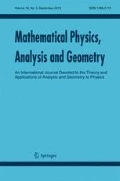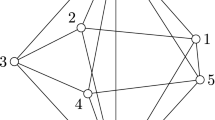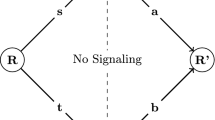Abstract
We describe the main classes of non-signalling bipartite correlations in terms of states on operator system tensor products. This leads to the introduction of another new class of games, called reflexive games, which are characterised as the hardest non-local games that can be won using a given set of strategies. We provide a characterisation of their perfect strategies in terms of operator system quotients. We introduce a new class of non-local games, called imitation games, in which the players display linked behaviour, and which contain as subclasses the classes of variable assignment games, binary constraint system games, synchronous games, many games based on graphs, and unique games. We associate a C*-algebra \(C^{*}(\mathcal {G})\) to any imitation game \(\mathcal {G}\), and show that the existence of perfect quantum commuting (resp. quantum, local) strategies of \(\mathcal {G}\) can be characterised in terms of properties of this C*-algebra. We single out a subclass of imitation games, which we call mirror games, and provide a characterisation of their quantum commuting strategies that has an algebraic flavour, showing in addition that their approximately quantum perfect strategies arise from amenable traces on the encoding C*-algebra.
Similar content being viewed by others
References
Atserias, A., Mančinska, L., Roberson, D.E., Šámal, R., Severini, S., Varvitsiotis, A.: Quantum and non-signalling graph isomorphisms. J. Comb. Theory B 136, 289–328 (2019)
Brown, N.P., Ozawa, N.: C*-algebras and finite-dimensional approximations. American Mathematical Society (2008)
Cameron, P.J., Montanaro, A., Newman, M.W., Severini, S., Winter, A.: On the quantum chromatic number of a graph. Electron. J. Comb. 14(1), 81 (2007)
Choi, M.D., Effros, E.G.: Injectivity and operator spaces. J. Funct. Anal. 24, 156–209 (1977)
Cleve, R., Liu, L., Slofstra, W.: Perfect commuting-operator strategies for linear system games. J. Math. Phys. 58, 012202 (2017)
Cleve, R., Mittal, R.: Characterization of binary constraint system games, Automata, languages, and programming. Part I, Lecture Notes in Comput. Sci., vol. 8572, Springer, pp. 320–33 (2014)
Connes, A.: Classification of injective factors. Ann. of Math. (2) 104, 73–115 (1976)
Cook, W.D., Webster, R.J.: Carathéodory’s theorem. Canad. Math. Bull. 15, 293–293 (1972)
Cubitt, T.S., Leung, D., Matthews, W., Winter, A.: Improving zero-error classical communication with entanglement. Phys. Rev. Lett. 104, 230503 (2010)
Dykema, K., Paulsen, V.I., Prakash, J.: Non-closure of the set of quantum correlations via graphs. Quantum Inf. Comput. 18, 599–616 (2018)
Effros, E.G., Ruan, Z.h.-J.: Operator spaces. Oxford University Press, Oxford (2000)
Farenick, D., Kavruk, A., Paulsen, V.I., Todorov, I.G.: Operator systems from discrete groups. Comm. Math. Phys. 329, 207–238 (2014)
Farenick, D., Kavruk, A., Paulsen, V.I., Todorov, I.G.: Characterizations of the weak expectation property, New York. J. Math. 24A, 107–135 (2018)
Farenick, D., Paulsen, V.I.: Operator system quotients of matrix algebras and their tensor products. Math. Scand. 111, 210–243 (2012)
Fritz, T.: Operator system structures on the unital direct sum of C*-algebras, Rocky Mountain. J. Math. 44(3), 913–936 (2014)
Helton, J.W., Meyer, K.P., Paulsen, V.I., Satriano, M.: Algebras, synchronous games, and chromatic numbers of graphs, New York. J. Math. 25, 328–361 (2019)
Holevo, A.S.: Quantum systems, channels, information. De Gruyter, Berlin (2013)
Junge, M., Navascues, M., Palazuelos, C., Perez-Garcia, D., Scholtz, V.B., Werner, R.F.: Connes’ embedding problem and Tsirelson’s problem. J. Math. Phys. 52, 012102 (2011)
Kavruk, A.S.: Nuclearity related properties in operator systems. J. Operator Theory 71(1), 95–156 (2014)
Kavruk, A., Paulsen, V.I., Todorov, I.G., Tomforde, M.: Tensor products of operator systems. J. Funct. Anal. 261(2), 267–299 (2011)
Kavruk, A.S., Paulsen, V.I., Todorov, I.G., Tomforde, M.: Quotients, exactness, and nuclearity in the operator system category. Adv. Math. 235, 321–360 (2013)
Kim, S.-J., Paulsen, V.I., Schafhauser, C.: A synchronous game for binary constraint systems. J. Math. Phys. 59(3), 032201 (2018)
Lami, L.: Non-classical correlations in quantum mechanics and beyond, PhD thesis. arXiv:1803.02902
Mančinska, L., Roberson, D.E.: Quantum homomorphisms. J. Combin. Theory Ser. B 118, 228–267 (2016)
Mančinska, L., Vidick, T.: Unbounded entanglement in nonlocal games. Quantum Inf. Comput. 15(15-16), 1317–1332 (2015)
Roberson, D.E.: Variations on a theme: Graph homomorphisms, Ph.D. thesis, University of Waterloo (2013)
Ortiz, C.M., Paulsen, V.I.: Quantum graph homomorphisms via operator systems. Linear Algebra Appl. 497, 23–43 (2016)
Ozawa, N.: About the Connes’ embedding problem–algebraic approaches. Japan J. Math. 8(1), 147–183 (2013)
Palazuelos, C., Vidick, T.: Survey on nonlocal games and operator space theory. J. Math. Phys. 57(1), 015220 (2016)
Paulsen, V.I.: Completely bounded maps and operator algebras. Cambridge University Press, Cambridge (2002)
Paulsen, V.I., Severini, S., Stahlke, D., Todorov, I.G., Winter, A.: Estimating quantum chromatic numbers. J. Funct. Anal. 270(6), 2188–2222 (2016)
Paulsen, V.I., Todorov, I.G.: Quantum chromatic numbers via operator systems. Q. J. Math. 66(2), 677–692 (2015)
Pisier, G.: Introduction to operator space theory. Cambridge University Press, Cambridge (2003)
Ramana, M.V., Scheinerman, E.R., Ullman, D.: Fractional isomorphism of graphs. Discrete Math. 132(1-3), 247–265 (1994)
Rao, A.: Parallel repetition in projection games and a concentration bound. SIAM J. Comput. 40(6), 1871–1891 (2011)
Slofstra, W.: Tsirelson’s problem and an embedding theorem for groups arising from non-local games, J. Amer. Math. Soc., in press. arXiv:1606.03140
Slofstra, W.: The set of quantum correlations is not closed, . Forum Math. Pi 7(e1), 41 (2019)
Slofstra, W., Vidick, T.: Entanglement in non-local games and the hyperlinear profile of groups. Ann. Henri Poincaré 19(10), 2979–3005 (2018)
Tsirelson, B.S.: Quantum generalizations of Bell’s inequality. Lett. Math. Phys. 4(4), 93–100 (1980)
Tsirelson, B.S.: Some results and problems on quantum Bell-type inequalities. Hadronic J. Suppl. 8(4), 329–345 (1993)
Acknowledgments
Part of this research was conducted during two Focused Research Meetings, funded by the Heilbronn Institute, and hosted at Queen’s University Belfast in October 2016 and March 2017. M. Lupini was partially supported by the NSF grant DMS-1600186. G. Scarpa acknowledges the support of MTM2014-54240-P (MINECO), QUITEMAD+-CM Reference: S2013/ICE-2801 (Comunidad de Madrid), ICMAT Severo Ochoa project SEV-2015-0554 (MIN-ECO), and grant 48322 from the John Templeton Foundation. The opinions expressed in this publication are those of the authors and do not necessarily reflect the views of the John Templeton Foundation.
Author information
Authors and Affiliations
Corresponding author
Additional information
Publisher’s Note
Springer Nature remains neutral with regard to jurisdictional claims in published maps and institutional affiliations.
Rights and permissions
About this article
Cite this article
Lupini, M., Mančinska, L., Paulsen, V.I. et al. Perfect Strategies for Non-Local Games. Math Phys Anal Geom 23, 7 (2020). https://doi.org/10.1007/s11040-020-9331-7
Received:
Accepted:
Published:
DOI: https://doi.org/10.1007/s11040-020-9331-7




